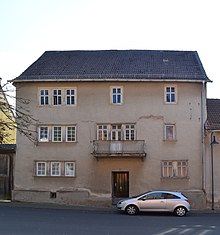Wehrheim Office

The Wehrheim office was an administrative and judicial district in today's Hochtaunuskreis . The main town was Wehrheim .
description
The zweiherrige Office Wehrheim was a sensitive structure. The main reason was that the state sovereignty was exercised jointly for centuries by the Catholic Kurtrier and the Protestant Nassau-Usingen . In order to limit the resulting conflicts, the respective competencies were defined down to the smallest detail. There was also a Kurtrier and a Nassau bailiff .
For the first time a bailiff is named in Wehrheim in 1386. However, until the 1520s, there were still compulsory labor from Wehrheim and (Langen) Anspach to Altweilnau , so that Wehrheim cannot actually be referred to as an office.
From 1543 Wehrheim was the seat of an electorate trier. In 1564, after the agreement between Trier and Usingen (the Diezer Treaty ), a Nassau bailiff was added. The Wehrheim office consisted of the Wehrheim, Anspach, Obernhain and the Thron monastery from 1579 . The Nassau official status from 1589 and the Electoral Trier official description from 1659 also name the same area. This means that the Wehrheim Office is spatially a spin-off from the Altweilnau Office .
When Kurtrier was dissolved in 1803, half of it was transferred to Nassau-Weilburg . With the merger of the Nassau territories to form the Duchy of Nassau in 1806, the centuries-old division ceased and the Wehrheim office became one of the offices of the Duchy .
With the reform of offices in Nassau on July 16, 1810, the Wehrheim office was combined with the Kransberg office in a new Cleeberg office . In 1814 this office became part of the Usingen office .
Officials or administrators
Kurtriersche officials
- 1543 Dietrich the Younger von Dietz
- 1583 From the rock to Limburg
- 1610–1628 Johann Andreas Vest
- 1643–1628 Johann Ludwig Vest
- 1659–1695 Johann Georg Vest
- 1695–1727 Johann Andreas Vest
- 1728–1735 Johann Balthasar Vest
- 1692–1710 N. Freiherr von Hohenfeld (senior magistrate)
- 1740 Knodt
- 1754 from Hohenfeld
- 1761 Franz Albert Hansen
- 1762–1802 Johannes Jacobus Finger
- 1802–1811 Hofrat Ludwig Westermann
Nassau officials
- 1386 Peter von Rumpenheim, called von Duzinbach
- 1815 Altcontze von Wehrheim, cellars from Wehrheim and Altweilnau
- 1572–1588 Dr. Jacob Schwartz, Nassau council and Wehrheim bailiff
- 1588–1589 Ludwig Eisenberger , his son-in-law
- 1619–1622 Nikolas Heinrich Eulner
- 1622–1643 Johann Eulner, his brother
- 1622 (appointed) Johann Ludwig Eulner, son of Nikolas Heinrich
- 1643–1648 Johann Balthasar Dauber
- 1651–1679 Johann Michael Eulner
- 1679–? Johann Michael Eulner, his son
- 1688–1708 Johann Ludwig Euler
- 1708–1710 Wilhelm Hartmann von Greifencron (Oberamtmann)
- 1709–1733 Johann Thomas Thomae
- 1733 Carl Christoph Hegemann
- 1741–1754 Philipp Johann Carl Gebhard (administrator)
- 1758– Johann Jacob Helmrich
- 1770–1795 Johann Georg Andreas Helmerich
- 1795–1809 Hermann Jacob Pagenstecher
See also
swell
- Jost Kloft: Territorialgeschichte des Kreises Usingen , Marburg 1971, ISBN 3-7708-0421X , page 184-185, page 214, page 217
- Annals of the Society for Nassau Antiquities and Historical Research : Volume 10, 1870, page 284 ( online )
- Peter Brommer : Kurtrier at the end of the old empire: Edition and commentary on the Electoral Trier official descriptions from (1772) 1783 to approx. 1790, Mainz 2008, Volume 2, ISBN 978-3-929135-59-6 , pp. 1115-1136.
Individual evidence
- ↑ Johanna Koppenhöfer, Wirena - Wehrheim, 2009, ISBN 978-3-00-028403-8 , page 93
- ↑ Johanna Koppenhöfer, Wirena - Wehrheim, 2009, ISBN 978-3-00-028403-8 , page 88


